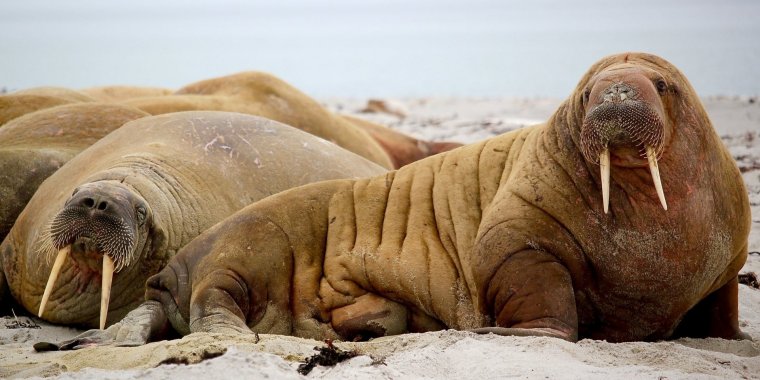| News / Science News |
Over-hunting walruses contributed to the collapse of Norse Greenland
The mysterious disappearance of Greenland’s Norse colonies sometime in the 15th century may have been down to the overexploitation of walrus populations for their tusks, according to a study of medieval artefacts from across Europe.

Over-hunting walruses contributed to the collapse of Norse Greenland. Photo: Jay Ruzesky/Unsplash
Founded by Erik the Red around 985AD after his exile from Iceland (or so the Sagas tell us), Norse communities in Greenland thrived for centuries – even gaining a bishop – before vanishing in the 1400s, leaving only ruins.
Latest research from the universities of Cambridge, Oslo and Trondheim has found that, for hundreds of years, almost all ivory traded across Europe came from walruses hunted in seas only accessible via Norse settlements in south-western Greenland.
Walrus ivory was a valuable medieval commodity, used to carve luxury items such as ornate crucifixes or pieces for games like chess and Viking favourite hnefatafl. The famous Lewis chessmen are made of walrus tusk.
However, the study also indicates that, as time wore on, the ivory came from smaller animals, often female; with genetic and archaeological evidence suggesting they were sourced from ever farther north – meaning longer and more treacherous hunting voyages for less reward.
Increasingly globalised trade saw elephant ivory flood European markets in the 13th century, and fashions changed. There is little evidence of walrus ivory imports to mainland Europe after 1400.
Dr James H. Barrett, from the University of Cambridge’s Department of Archaeology, argues that the Norse abandonment of Greenland may have been precipitated by a “perfect storm” of depleted resources and volatile prices, exacerbated by climate change.
“Norse Greenlanders needed to trade with Europe for iron and timber, and had mainly walrus products to export in exchange,” said Barrett, lead author of the study.
“We suspect that decreasing values of walrus ivory in Europe meant more and more tusks were harvested to keep the Greenland colonies economically viable.”
Other theories for collapse of the colonies have included climate change – the “Little Ice Age”, a sustained period of lower temperatures, began in the 14th century – as well as unsustainable farming methods and even the Black Death.
“An overreliance on walrus ivory was not the only factor in Norse Greenland’s demise. However, if both the population and price of walrus started to tumble, it must have badly undermined the resilience of the settlements,” says co-author Dr Bastiaan Star of the University of Oslo. "Our study suggests the writing was on the wall."
The researchers also studied traces of “manufacturing techniques” – changing styles of butchery and skull preparation – to help place the walrus remains in history.
While impossible to determine exact provenance, the researchers detected a shift in European walrus finds around the 13th century to walruses from an evolutionary branch most prevalent in the waters around Baffin Bay.
These animals must have been hunted by sailing northwest up the Greenland coast, and more recent specimens were smaller and often female. “If the original hunting grounds of the Greenland Norse, around Disko Bay, were overexploited, they may have journeyed as far north as Smith Sound to find sufficient herds of walrus,” said Barrett.
Norse artefacts have previously been found among the remains of 13th and 14th century Inuit settlements in this most northern of regions. One former Inuit camp on an islet off Ellesmere Island contained the rivets of a Norse boat – quite possibly a hunting trip that never returned.
“Ancestors of the Inuit occupied northern Greenland during the time of the Norse colonies. They probably encountered and traded with the Norse,” said Barrett. “That pieces of a Norse boat were found so far north hints of the risks these hunters might have ended up taking in their quest for ivory.”
Barrett points out that the Inuit of the region favoured female walruses when hunting, so the prevalence of females in Greenland’s later exports could imply a growing Norse reliance on Inuit supply.
He says that hunting season for the Norse would have been short, as seas were choked with ice for much of the year. “The brief window of summer would have barely been sufficient for rowing the many hundreds of miles north and back.”
The legend of Erik the Red itself may mask what Barrett calls “ecological globalisation”: the chasing of natural resources as supply dwindles. Recent research revealed that Greenland might have been settled only after Icelandic walruses were hunted to exhaustion.
Ultimately, having been highly prized for centuries, the marbled appearance of walrus ivory fell out of favour as West African trade routes opened up, and the homogenous finish of elephant ivory became de rigueur in the 13th century. (University of Cambridge)
YOU MAY ALSO LIKE





